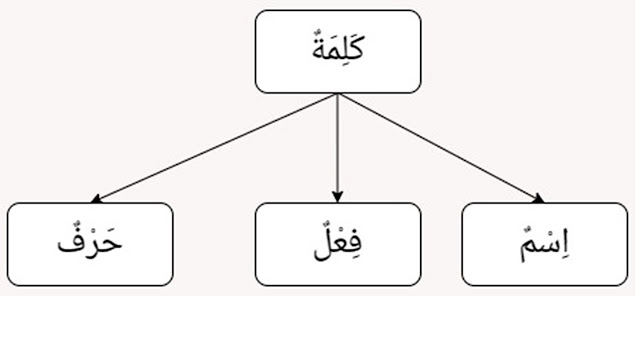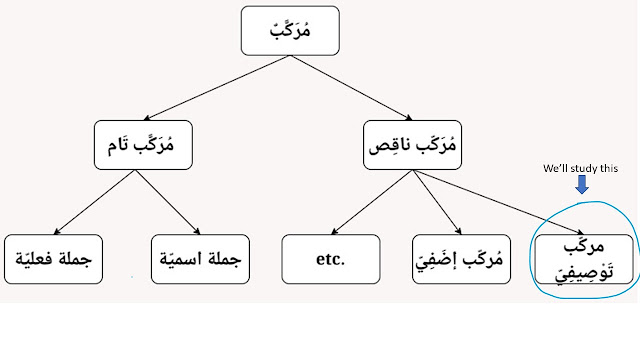Arabic Language Fundamentals: Learning About Na't and Man'ut
We have studied a word (كلمة). We have known that there are three types of a word in the Arabic language, they are اسم (a noun), فعل (a verb), and حرف (a particle).
After studying كَلِمَةٌ (a word), we are going to learn compound or a combination of two or more words.
The compound in Arabic is called مُرَكَّبٌ (murakkab).
Type of مُرَكَّب (compound) in Arabic
There are two types of compounds, they are:
1. مُرَكّب ناقِص (incomplete compound).
It is called incomplete because the combination of words generates an incomplete statement. In other words, this combination of words is not a sentence.
Examples:
بَيْتٌ جَمِيْلٌ (baytun jamiil): a beautiful house.
فِي المَدْرَسَةِ (fi al-madrasati): in the school.
قَلَمُ زَيْدٍ: Zaid's pen.
2. مُرَكَّب تَام (complete compound).
The combination of the words generates a complete statement or a sentence.
Examples:
البَيْتُ جَمِيْلٌ (al-baytu jamiilun): The house is beautiful.
خَذِ القَلَمَ (khudh al-qalam): Take the pen.
زَيْدٌ فِي المَدْرَسَةِ (Zaid fi al-madrasati): Zaid is in the school.
This complete compound is also called جُمْلَةٌ (jumlah) or كَلاَمٌ (kalam).
جُمْلَةٌ or كَلاَمٌ means a sentence.
Types of مُرَكّب ناقِص (incomplete compound)
There are several types of incomplete compounds, such as:
a. مركّب تَوْصِيفِيّ (adjectival phrase).
It consists of two components, they are an adjective and a noun.
An adjective modifies or describes a noun, whereas the noun is modified or described by the adjective.
In Arabic, the adjective is called نَعْتٌ (na't), whereas the noun is called مَنْعُوتٌ (man'ut).
We can say صِفَةٌ (sifah) instead of نَعْتٌ (na't), and مَوْصُوفٌ (mawsuf) instead of مَنْعُوتٌ (man'ut).
Example:
بَيْتٌ جَمِيلٌ (a beautiful house).
جَمِيلٌ is called نَعْتٌ or صِفَة
بَيْتٌ is called مَنْعُوت or مَوصُوف
Recap
There are two component that construct مركّب تَوْصِيفِيّ, they are نعت ومنعوت or صفة وموصوف (na't wa man'ut or sifah wa mawsuf).
- the adjective: نعت, صفة
- the noun that is modified: موصف, منعوت
b. مُركّب إضَفِيّ (annexation structure/genitive construct).
مُركّب إضَفِيّ consists of two component, they are مُضَافٌ (the thing annexed), and مُضافٌ إِلَيهِ (the annexer).
Example:
بَيْتُ زَيْدٍ: Zaid's house.
بَيْتُ is called مُضَاف (mudaf).
زَيْدٍ is called مُضَاف إليه (mudaf ilaih).
You can restudy this construction here: idafah basic structure and the rules
In this lesson, we only focus on مركّب تَوْصِيفِيّ, and the term we will use are نَعت and منعوت.
نَعْتٌ وَمَنْعُوتٌ: The Basic Rules
Here are the key points of the rules:
1. In adjectival phrase (نَعْتٌ وَمَنْعُوتٌ): The second word (منعوت) describes the first word (نعت).
بَيْتٌ جَمِيْلٌ: a beautiful house.
a. The second word is جَمِيْلٌ.
In this case, we name it as نَعْتٌ.
It describes the word "بَيْتٌ".
b. The first word is بَيْتٌ.
In this case, we name it as مَنْعُوتٌ.
It is described by the word "جَمِيلٌ".
The word "جَمِيل" describes the word "بَيت" with the quality of beauty.
2. Na't and man'ut agree on number, definiteness, case or declension, and gender.
a. If man'ut is singular, the na't will also be singular. If man'ut is dual, the na't will also be dual. If man'ut is plural, the na't will also be plural.
Examples:
- بَيْتٌ جَمِيْلٌ: a beautiful house.
بَيْتٌ (as a man'ut) is singular, so جَمِيْلٌ (as a na't) is also singular.
- بَيْتَانِ جَمِيلاَنِ: two beautiful houses.
بَيْتَانِ is dual, and جَمِيلاَنِ is also dual.
- رِجَالٌ جُمَلاَءُ: handsome men.
رِجَالٌ is plural, and جُمَلاَءُ is also plural.
Note: رِجَالٌ is plural form. The singular form of رِجَالٌ is "رَجُلٌ". And جُمَلاَءُ is plural form of جَمِيلٌ.
We will learn the dual and plural forms in the next chapter.
b. If man'ut is definite, the na't will also be definite. If man'ut is indefinite, the na't will also be indefinite.
Examples:
- رَجُلٌ جَمِيْلٌ: a handsome man.
رَجُلٌ is indefinite form, so جَمِيْلٌ is also indefinite.
- الرَّجُلُ الجَمِيْلُ : the handsome man.
الرَّجُلُ is definite, and so is الجَمِيْلُ.
Note:
- Definite noun in Arabic is اسم معرفة (ism ma'rifah).
- Indefinite noun in Arabic is اسم نكرة (ism nakirah).
c. If man'ut is مرفوع (nominative case), the na't will also be مرفوع. If man'ut is منصوب (accusative case), the na't will also be منصوب. If man'ut is مجرور (genitive case), the na't will also be مجرور.
Examples:
- قَلَمٌ جَدِيْدٌ: a new pen.
قَلَمٌ is in nominative case or marfu'. The indication of marfu' is dammah "u".
جَدِيْدٌ is marfu', the indication of marfu' is dammah "u".
- خُذْ هَذَا قَلَمًا جَدِيْدًا: Take this new pen.
قَلَمًا is in accusative case or mansub. The indication of mansub is fat-hah "a".
جَدِيْدًا is in accusative case or mansub. The indication of mansub is fat-hah "a".
- كَتَبْتُ بِالقَلَمِ الجَدِيْدِ: I wrote with the new pen.
القَلَمِ is in genitive case or majrur. The indication of majrur is kasrah "i".
الجَدِيْدِ is in genitive case or majrur. The indication of majrur is kasrah "i".
d. If man'ut is masculine, the na't will also be masculine. If man'ut is feminine, the na't will also be feminine.
Examples:
- رَجُلٌ جَمِيْلٌ: a handsome man.
رَجُلٌ and جَمِيْلٌ are masculine noun.
- اِمْرَأَةٌ جَمِيْلَةٌ: a pretty woman.
اِمْرَأَةٌ is feminine noun, and جَمِيْلَةٌ is also feminine noun.
Note:
- Masculine noun in Arabic is اسم مذكّر (ism mudhakkar).
- Feminine noun in Arabic is اسم مؤنّث (ism mu-annath).
Vocabulary List
Memorize the following words.
بَيْتٌ: house
مَسْجِدٌ: masjid
بُسْتَانٌ: garden
شَايٌ: tea
مَاءٌ: water
وَلَدٌ: boy
دَرْسٌ: lesson
كِتَابٌ: book
قَلَمٌ: pen
كَبِيْرٌ: big
صَغِيْرٌ: small
نَظِيْفٌ: clean
حُلْوٌ: sweet
صَالِحٌ: pious
سَهْلٌ: easy
جَمِيْلٌ: beautiful
عَرِيْضٌ: broad
جَيِّدٌ: good
شَارِعٌ: street
Once you memorized, let's finish the exercises.
Exercises
Translate the phrases into English:
1. البَيْتُ الكَبِيْرُ
2. البُسْتَانُ النَّظِيْفُ
3. شَايٌ حُلْوٌ
4. وَلَدٌ صَالِحٌ
5. الدَّرْسُ السَّهْلُ
Key Answers
1. The big house.
2. The clean garden.
3. a sweet tea.
4. a pious boy.
5. The easy lesson.






No comments:
Post a Comment